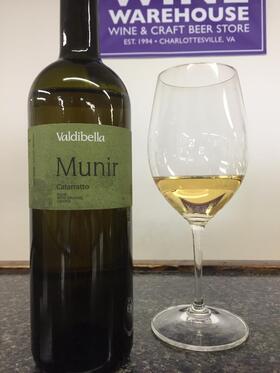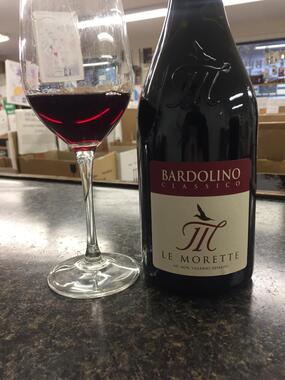 The Catarratto grape is (yet another) one of those Italian varieties that few people have heard of unless they live or spend time in the regions they are featured. Even in Sicily it went largely under-appreciated until the last part of the 20th century when the wines of Mount Etna earned recognition. Like the red wines, the Catarratto based white wines most sought after come from older vineyards and often with an increasingly steep price tag due to the limited sources. This makes it hard for the novice customer to dip their toes in and see if this is a grape that fits their palate. Thankfully the growers on the island are increasing their planting, and importers are becoming increasingly able to source better values like this for consumers to test drive. Valdiabella is a unique cooperative of organic family farms near Palermo that pool their resources for several products, including this very reasonable lineup of wines featuring native Sicilian varieties. A rich golden straw color in the glass, the aromas at first have a bit of the baked apple you may find in some unoaked Chardonnays, but picks up more crisp green citrus and herbal tints as it opens up. There isn't the driving minerality on the nose that comes from the volcanic soils around Mount Etna, more warmth and softness, but still very distinct and inviting. On the palate the texture is also warm and apple-y, with a touch of melon rind and green apple skin to the finish that brings out the fresher flavors, and with successive mouthfulls it gets more zesty and mouthwatering. A tasty introduction to this Sicilian variety and an ideal pairing to fish and poultry dishes with big herbal flavors.
0 Comments
 South Africa has a long and complicated history with Europe and the rest of the world over the centuries of colonialism. The French have a strong influence on the history of wine industry here, not surprisingly, and has been a major factor in the country's reemergence since the fall of apartheid in the early 1990s. May de Lencquesaing was the matriarch of the esteemed wine chateau Pichon Longueville Comtesse de Lalande, with family roots that traced back to the 1780 when her ancestor was appointed 'royal wine broker' for South Africa. In the late 1990s she set out to reconnect with those past ties by purchasing an estate in the Stellenbosch wine region, the oldest established wine area in South Africa near the port city of Cape Town. The property Glenelly sits on what was part of the original Ida's Valley farm ceded over to a French Huguenot family in 1682, which had vineyards through much of its history but in more recent time had been converted to solely fruit trees. Since taking over the winery has built itself up with a Bordeaux mindset as well as a bit of New World technology and sensibility, becoming one of the more impressive 'newer' producers in the country. Primarily Cabernet Sauvignon and dominated by the other traditional Bordeaux varieties (Merlot, Cabernet Franc and Petit Verdot), this does have a healthy splash of Syrah in the blend, which have been a common aspect of the reds in this part of the world. What's uncommon here is the quality and intensity this wine is bringing for the money, drinking and smelling like a young Bordeaux that could bring twice the price. Deep in color but showing the slightest bit of color change at the edges from a bit of needed time in the bottle before release, the aromas are very Old School Bordeaux with lots of dark currant, black pepper, coffee roast, cedar and spice. As it opens up there may be a little more warmth of fruit and sweetness of spice to indicate it isn't French in origin, but it's pretty darn close. The texture in the mouth is equally big and bold, but with tannins that are surprisingly fine and polished, most likely thanks to the added Syrah and the bit of extra time cellaring as well. It makes for a wine that is fairly ready to drink right now, though it does have the potential to evolve much more if you wanted to. Either way there is lots of value here for Old World and New World fans alike.  A treat for Valentine's Day, reminding us that Champagne isn't the answer for every sparkling wine need, as well as that the fact that sweetness in a wine should be a wonderful thing when done correctly. This wine comes from Beaujolais and uses the 'methode ancestrale' to create the bubbles, which is different from the 'methode traditionelle' used in making Champagne and other like-minded sparkling wines in that it doesn't use a secondary fermentation in the bottle. That bottle fermentation is what allows the wine to have carbonation and be made completely dry, while ancestrale is only able to take the wine down to 8%-9% abv and still keep its carbonation. The ancestrale method exists well before the monks in Champagne refined their process, and many examples persist to this day in regions like Bugey Cerdon in Savoie and Clairette de Die in the Rhone that are OK with making a bubbly wine with a little bit of natural sugar left behind. It is important to remember this is very different from a Moscato d'Asti and the wines made in that method, as those wines are much lower in carbonation (no 'cork and cage' Champagne type stopper because of the pressure) and their alcohol is much lower due to less sugar being fermented out. There are no added outside sugars, no cheap shortcuts. And in the broad continuum of dry to sweet, this doesn't come across cloying at all, more of the sweet taste of fresh berries, natural and delicious. Pouring with a youthful purple color and grape-y tinted foamy bubble that lingers at the edges in the glass, the aromas are somewhere between a juicy Beaujolais and a old school soda fountain drink, savory red berries mixed with cola and sarsaparilla. Don't know if it's the carbonation that brings out the soda-ish parallels, but they definitely show through more as the wine gets warmer, while the vinous aromas show more when the wine first comes out of the fridge. On the palate the flavors are fresh and grape-y, with very little sense of sugar or anything coating the palate, with a very fine prickle of carbonation and a dusty tannin creating a fairly dry sensation on the finish. A great lighter weight foil for less intensely sweet chocolates or chocolate-based desserts, but also worth pairing with lighter savory snacks, Beaujolais style, if you just don't want anything weighing you down with much alcohol.  Valpolicella is the most famous of the red wine regions near the Italian city of Verona, deservedly so because of the high quality and the reputation of higher end wines like Amarone. Just to the West, along the banks of Lake Garda, Bardolino sits in relative anonymity by comparison, utilizing the same grapes to similar levels of excellence but mostly just selling them to the lakeside population. Every once in a while, a delicious few will escape the lake and make it over our way. From the original area of Bardolino closest to the lake (which earns it the 'Classico' designation) this is parallel to a Valpolicella Classico in that there is no use of dried grapes or pressings the way an Amarone or Ripasso, just featuring the Corvina, Rondinella and Molinara grapes in their purest form. The biggest difference between the two regions is the higher elevation up in the mountains along the lake, giving the wines a slightly lighter body and a brighter underlying acidity. You will also tend to see less usage of oak here, especially newer barrels, so the wines tend to lean towards freshness and very natural expressions. A deep dark cherry color in the glass, the aromas are a seductive array of red fruits with hints of tartness in the background and an almost sarsaparilla/old school root beer note that also kicks into light spices. Nothing sweetened at all here, no extracted heavy tones in the nose at all, and it extends onto the palate as well. Very soft texture with virtually no tannins, somewhat of a Beaujolais type fruit softness to the dark cherry notes and just the lightest of dustiness to the finish. This is ideal to pair with savory meat dishes that aren't fatty and don't need a robust wine to lean on, likewise a mushroom or lentil heavy vegetarian dish. |
The Best of the Best.We offering free tastings on these wines in the store every Thursday and Friday, and a 10% discount off the retail price through the duration of the day. Come on by and give them a try! Archives
July 2024
Categories |
Location |
|

 RSS Feed
RSS Feed